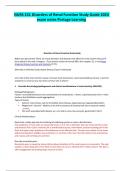Samenvatting
Taal en Cognitie in normale en verstoorde ontwikkeling Samenvatting tentamen
Dit is een samenvatting van zowel de artikelen als de hoorcolleges voor het vak Taal en Cognitie in Normale en Verstoorde Ontwikkeling aan de Universiteit Utrecht.
[Meer zien]













